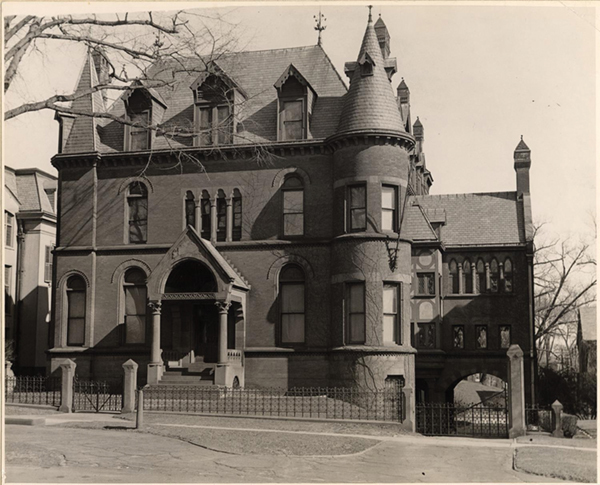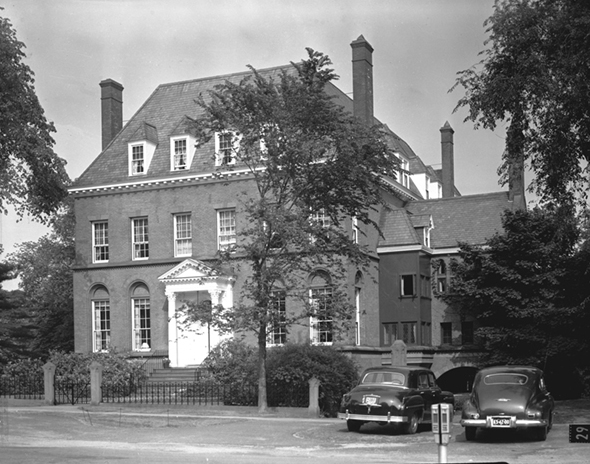
Manuscripts and Archives
43 Hillhouse Avenue was built in 1871 for railroad magnate Henry Farnam in Victorian Gothic style.
View full image

Manuscripts and Archives
43 Hillhouse Avenue was built in 1871 for railroad magnate Henry Farnam in Victorian Gothic style.
View full image

Manuscripts and Archives
Before it became the Yale President's House in 1937, it was renovated to look more fashionably Georgian.
View full image

Manuscripts and Archives
Before it became the Yale President's House in 1937, it was renovated to look more fashionably Georgian.
View full image
When Maurie McInnis ’96PhD was offered the job of Yale president, one thing she and her husband Dean Johnson did not have to worry about was finding a place to live in New Haven. Like her seven most recent predecessors, McInnis has the use of an imposing house at 43 Hillhouse Avenue, thanks to a long-ago gift.
Official presidential residences have an on-again, off-again history at Yale. In 1722, not long after the college moved from Saybrook to New Haven, Yale built a house on College Street (about where the Anchor bar is today) to serve as a residence for its rector—as the top official was then called. It was replaced in 1800 by a house on the Old Campus that was used until 1846. After that, for the next 78 years, the presidents lived in their own houses.
We have Henry Farnam (1803–1883) to thank for the current president’s house. Farnam, who got his start as a surveyor on the Erie Canal, first came to New Haven in 1825 to work on the Farmington Canal. He became a partner of Joseph Sheffield, who owned the canal and later turned it into a railroad line. The two would go on to make fortunes developing railroads in the Midwest. Farnam chose to return to New Haven for a genteel retirement in the garden “suburb” of Hillhouse Avenue.
In 1863, the year he retired, he gave Yale the money to build Farnam Hall, the first of the dormitories that eventually turned the Old Campus into a walled quadrangle. In 1871, the year after Farnam Hall was completed, the Farnams moved into an imposing mansion at 43 Hillhouse. It was designed by Russell Sturgis, the architect of Farnam Hall and its later Old Campus neighbors, Durfee and Lawrance Halls and Battell Chapel.
Farnam’s house bore a great resemblance to Sturgis’s Victorian Gothic work on the Old Campus: thick, dark stone-and-brick walls, round towers with sharply peaked roofs, and wooden dormers. At the time, it was the finest house on the avenue and perhaps the finest in the city.
When Farnam died in 1883, Yale had no designated president’s house. He left 43 Hillhouse to the university in his will for that purpose, but with the provision that his wife and son could continue to live there until their deaths. His wife died in 1904, but his son, Yale economics professor Henry Walcott Farnam ’74, lived—and occupied the house—until 1933. Perhaps seeing a long wait ahead, Yale bought the house next door, 47 Hillhouse, as a residence for president James Rowland Angell in 1923.
By the time 43 Hillhouse fell into Yale’s hands, its Victorian style was seen as hopelessly outdated. In the early twentieth century, tastemakers preferred the cleaner lines and brighter interiors of Georgian and Colonial architecture. So the university hired New York architects Richard Kimball ’22, ’27BFA, and Ellery Husted ’24 to give it a stylistic makeover: the tall, thin, Victorian windows were replaced with square-paned Georgian ones, the pointed-arch porch was removed, and two turrets were pulled down. As architectural historian Elizabeth Mills Brown put it in her guide to New Haven architecture, “In 1934 no one had a good word to say for Victorian architecture. Today this poor house testifies to the lengths people were willing to go to express their dislike.”
Charles Seymour ’08, ’11PhD, was the first president to occupy the house, beginning in 1937. The house and its sweeping lawn soon became a spot for parties and annual events, including an annual reception for incoming first-year students. Presidents from A. Whitney Griswold ’29, ’33PhD, to A. Bartlett Giamatti ’60, ’64PhD, spent their terms living in the house with their families. Benno Schmidt Jr. ’63, ’66LLB, used the house as a residence, but his family remained in New York City during his presidency.
In 1993, when Richard Levin ’74PhD became president, he and his family opted to stay in their own house in New Haven, using 43 Hillhouse only for social occasions. “It’s not like a cozy place you can sit around and watch a ball game,” Levin told the Yale Daily News at the time. His successor, Peter Salovey ’86PhD, renewed the custom of occupying the house. After a renovation in 2014, he and his wife, Marta Moret ’84MPH, moved in to a small one-bedroom apartment in the rear of the house. McInnis will divide her time between 43 Hillhouse and a family residence that is close to campus.
Although the house has nearly everything a president could want, one thing it doesn’t have is neighbors. In Farnam’s day, New Haven’s intellectual and financial elite lived and socialized on the avenue. But now, all of the 14 houses that remain on Hillhouse are owned by the university. The President’s House is the only one currently in use as a residence.
 loading
loading